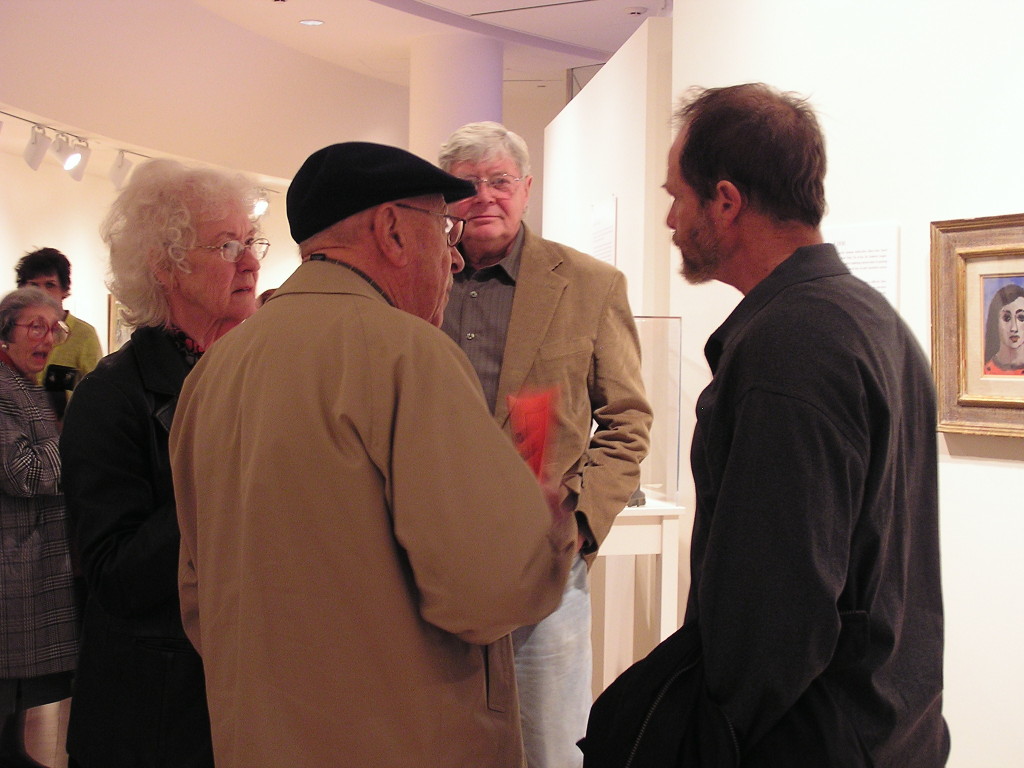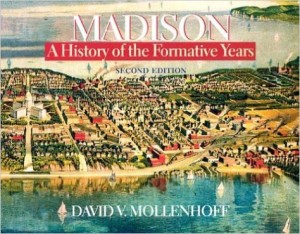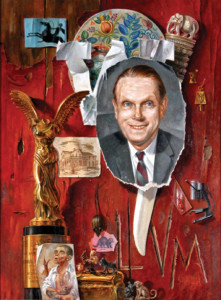
In 1963, one year following the death of his dear friend and the illustrious thirteenth president of the University of Wisconsin, Conrad Elvehjem, Aaron Bohrod painted this work. The Wisconsin Union purchased it that same year and it is part of its permanent collection.
There was a time during the late 1960s, when Aaron Bohrod’s trompe l’oeil painting seemed ubiquitous – at least in Madison, at least in my still-then relatively small universe.
Bohrod was the University of Wisconsin’s artist-in residence from 1948 to 1973. In 1963, Bohrod painted a portrait of Conrad Elvehjem, the thirteenth president of the University of Wisconsin, for whom the Elvehjem Museum of Art was named. In 1966, the Madison Art Center hosted “Aaron Bohrod: a retrospective exhibition, 1929-1966” and the University of Wisconsin Press published Bohrod’s autobiographical, “A Decade of Still Life.” And in 1967, one of his paintings graced the cover of “Compositions for Cooking,” a collection of recipes compiled by the Women’s Committee of the Madison Civic Music Association.
In the years since then, Madison seemed to forget about Bohrod, although this is perception, not reality. In 1995, for instance, The Wisconsin Academy Review published an illustrated article about the art of Aaron Bohrod, as well as that of his son Neil and Neil’s wife, Ruthanne Bessman. In 1984, Sue Ann Kendall recorded an oral interview with Aaron Bohrod for the Archives of American Art, Smithsonian Institution.
I never forgot about Bohrod, perhaps because a friend’s parents owned several of his paintings. Or perhaps because Neil Bohrod attended Wisconsin High School, as did many of my friends. Although I don’t recall ever meeting Neil, I knew where he and his family lived because the Bohrod house on the shores of Lake Monona was near the home of some of my cousins. In addition, I truly admired Aaron Bohrod’s paintings.
Two months ago, when I attended the public reception for the opening of “Small Arms – Children of Conflict: Photographs by Michael Kienitz ” at the Chazen Museum of Art, I had an opportunity to talk with a woman I’d attended grade school with (and who had subsequently opted to attend Wisconsin High School while I opted to attend Madison Central High School) and somehow the conversation drifted into a discussion of Aaron Bohrod and why Madison seemed to have forgotten about him – why, for instance, there had been not recent exhibition of his work. She’d heard rumors about a large collection of unseen Bohrod work still in storage. Perhaps it was a story I should consider investigating, she suggested. Perhaps it was – but as is too often the case, I had something else to do.
Unbeknownst to Mary and me, the game was already afoot. Several weeks later, I learned that the Wisconsin Academy of Arts, Sciences, and Literature would be hosting an exhibition, “Aaron Bohrod: A Life and Still Life,” at the James Watrous Galley in the Overture Center for the Arts. Hurrah! An opportunity to see some of Aaron Bohrod’s work in a public setting.
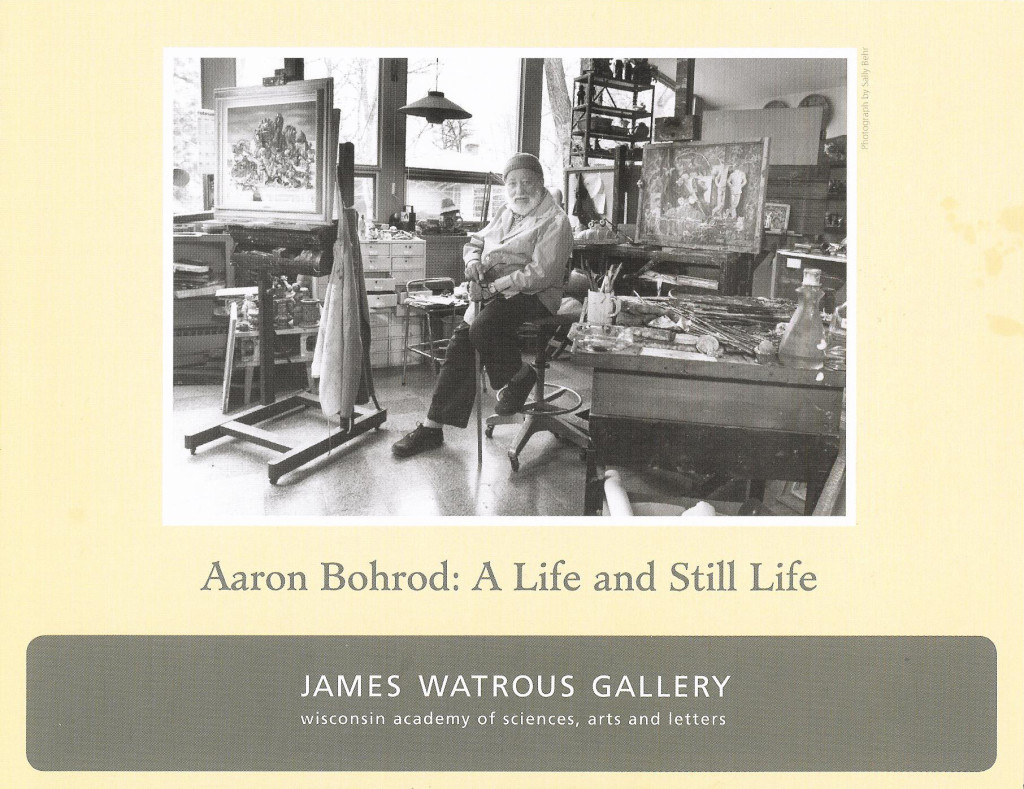
On Friday, November 2, I attended the opening reception for the exhibit. Opening nights, whether at theaters or in art galleries, are full of hoopla about many things other than the subject at hand: They’re about seeing and being seen, about the food, about the buzz. Gallery openings are usually so crowded you don’t really have an opportunity to see and enjoy the art. Openings give you a taste of what’s on tap, and if you’re fortunate (and the subject proves worthy), you’ll find the time to revisit the theater or the gallery when there’s enough time and space to really immerse yourself in art.
The opening reception for the Aaron Bohrod exhibition had a crowd that packed the relatively small Watrous Gallery; an ample and attractive selection of edible treats in an adjoining room, and featured a short talk by Robert Cozzolino, who wrote an essay about “Aaron Bohrod at 100” for the current issue of Wisconsin People & Ideas. I wandered around, took a few photographs, talked to some people I hadn’t seen in a long time, checked out the buffet, and decided I definitely needed to return to the Watrous Gallery on a quieter, less-crowded day to soak up all the wondrous objects and information on exhibit – especially the art Bohrod created prior to 1953, when he abandoned all genres except still life.
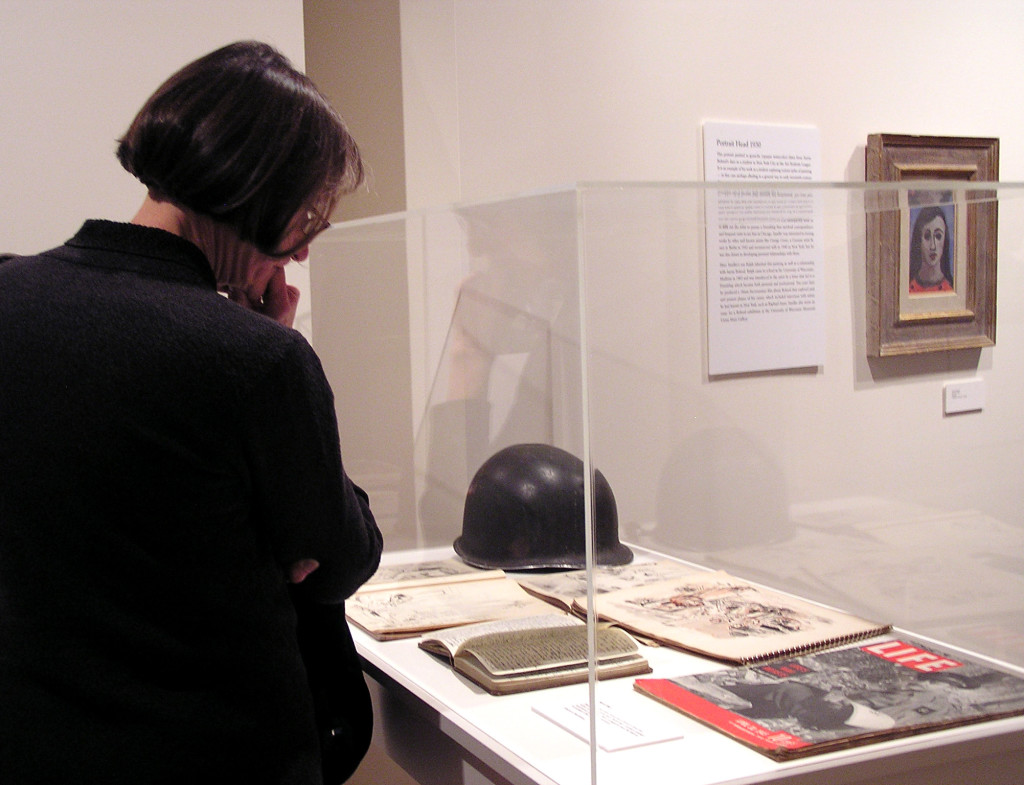
During World war II, Bohrod worked as a Life magazine correspondent and accompanied General Patton’s Third Army into Germany.
You’ll probably find another post here about Bohrod after I revisit the exhibit. In the meantime, I hope you’ll take a look at a few of the less than wonderful photographs I took at the opening reception, follow some of the links I’ve included in this post to learn more about Bohrod, and then hie down to the Overture Center to see the exhibit for yourself.
On Sunday November 18, 2007 you can enjoy the exhibit and a piece of cake. At 2 p.m. by Tom Lidtke, Executive Director of the Museum of Wisconsin Art will give a lecture about Bohrod at the Watrous Gallery. A birthday celebration will follow. This event has been scheduled close to what would have been Aaron Bohrod’s 100th birthday.
NB: If some of those organization names in the second paragraph of this post seem “wrong” or unfamiliar, it’s because over the past four decades they’ve morphed into something else. Back in the 1960s, before the restructuring that created the University of Wisconsin System, the “University of Wisconsin” referred only to the Madison campus. The Elvehjem Museum of Art is now, thanks to a $20 million gift, the Chazen Museum of Art. The Madison Art Center is now the Madison Museum of Contemporary Art. The Madison Civic Music Association is now the Madison Symphony Orchestra.
<
